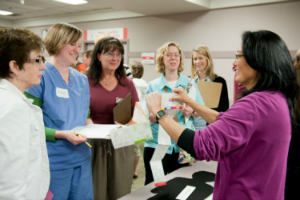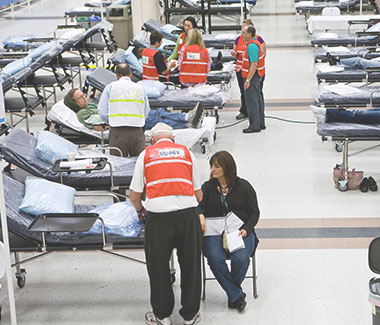

Tracking loved ones during a disaster
On September 24, 2015, a Ride the Ducks tour vehicle collided with a charter bus carrying 45 international students and staff from North Seattle College on Seattle’s busy Aurora Bridge. Five people were killed and 71 injured in the largest multi-casualty incident Seattle had experienced. On what was likely one of the worst days the victims’ families had seen, emergency plans and tools facilitated the exchange of critical information about the patients’ whereabouts and conditions.
Tracking Critical Information
Within minutes of the crash, the Seattle Fire Department was on scene triaging injuries, while the city’s Office of Emergency Management (OEM) opened its Emergency Operations Center. Once notified by OEM, the Northwest Healthcare Response Network (the Network), which leads the regional healthcare coalition, issued an alert through WATrac, an online healthcare communication and resource tracking system that hospitals use daily across the state. Each Seattle hospital was prompted to update its bed availability, facilitating the distribution of nearly 60 accident victims to seven area hospitals and one urgent care center.
The OEM coordinated among 15 separate city departments and 11 partner agencies to manage complexities ranging from the massive traffic impacts to the notification of consulates representing the 14 foreign countries from which the accident victims hailed. It relied on the Network for assistance in tracking the location and condition of each of the patients.
“The very definition of a disaster is that there’s chaotic, unconfirmed information,” says OEM Director Barb Graff. “Trying to get your arms around whether you got ahold of everybody is no small task. But the Network made it so easy on us.”
Exercises conducted through the years had identified a need for a standard way to track patients through the healthcare system in a mass casualty incident. In response to this gap, the Network began the implementation of WATrac, a web-based application that includes a patient tracking system. Within two hours of the bus crash, the Network launched the first disaster activation of WATrac, asking hospitals to input basic demographic information about the patients and update their status as they moved through the continuum of care.
The Network held the master patient roster, with staff members working as liaisons in the Emergency Operations Center. Using their strong relationships with emergency managers, they streamlined the exchange of information and minimized the number of phone calls so healthcare facilities could focus on their top priority—providing quality, efficient medical care to the accident victims.
Family Reunification
The patient tracking system also allowed Public Health-Seattle & King County (PHSKC), the local health department, to provide information to families who called into its Family Reunification Hotline, which received more than 70 calls in the two days following the accident. “We could not have operated the call center without the patient tracking piece,” says Response Planning Program Manager Ashley Kelmore. “We wouldn’t have had the information to effectively respond to the callers.”
Managing Resources
The patient tracking system also benefited non-hospital healthcare organizations involved in regional preparedness planning. Bloodworks Northwest, which has been involved with the Network since its inception as the King County Healthcare Coalition in 2005, provides blood products and services to nearly 90 hospitals in Washington, Oregon and Alaska, had been trained in the use of the WATrac patient tracking system. After the accident, staff used the tool to anticipate which healthcare facilities would likely need blood products based on the listed patient conditions.
With this information, Bloodworks Northwest’s ability to support the hospitals contrasted markedly with the response to a shooting at Umpqua Community College in Roseburg, Oregon, the following week, says President and CEO Dr. Jim AuBuchon. “Even though all the seriously injured patients in Roseburg ended up at one facility that we serve, we had more difficulty finding out the condition of the patients, the likelihood of their need for transfusion, the availability of the components and what restocking might be needed,” he says.
PHSKC Preparedness Director Carina Elsenboss, who has worked in healthcare preparedness in the Puget Sound for more than 12 years, says the patient tracking system made a “night and day” difference compared to the many exercises she’s participated in over the years in which there was no central database of patient information.
Addressing the Gaps
Yet the incident also highlighted further work to be done, says the Network’s Western Washington Planning Support Coordinator Rebecca Lis. “It was an opportunity to test where we were, but also to reinforce what we can do,” Lis says. “It gave us momentum with the community and an understanding that this is something we all need to invest time in, and we’re on board with.” Since the accident, nearly all regional healthcare facilities have been trained in the use of WATrac’s patient tracking system.
At Seattle OEM, Graff has partnered with the Network for years in exercises and responses to infectious disease outbreaks and weather hazards. She says the city has come to rely on the Network and its tools like WATrac to be the voice for and liaison to the regional healthcare system in emergencies, a role no city department has the expertise or relationships to fill. “On our worst day, this is one thing we’ve taken care of that won’t go wrong for us,” she says. “The week that we were activated for the bus crash verified why it was vital to have that kind of a network and have a good working relationship with it. I think they proved their value in that activation.”
In A Disaster
The work of the coalition allows healthcare in our community to:
- Distribute patients to the appropriate hospitals
- Track patients’ location and conditions
- Use a single point of contact for healthcare information
- Anticipate medical facilities’ resource needs
Other Impact Stories

Impact Focus:
Multi-Agency Coordination
Ensuring Capacity...
The Challenge At least 25% of the population of the state of Washington is a pediatric patient, specifically under the… Read more »

Impact Focus:
Evacuation
Partnerships and...
Challenge: Relocating 77 vulnerable residents from a skilled nursing facility in rural Washington during a fire evacuation emergency. Montesano, Washington… Read more »

Impact Focus:
Situational Awareness
Extreme Heat...
The Network spearheads coordination and collaboration to save lives during an extreme heat response. In late June 2021, amidst a… Read more »

